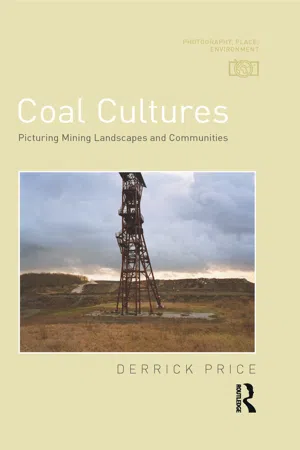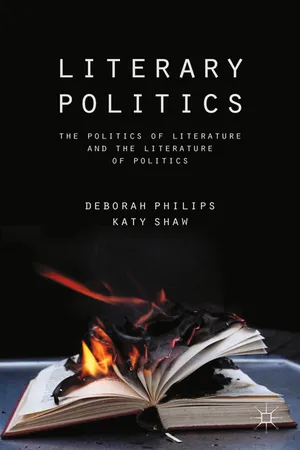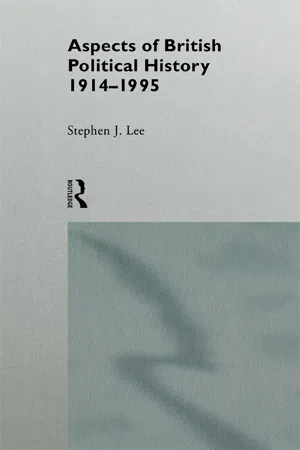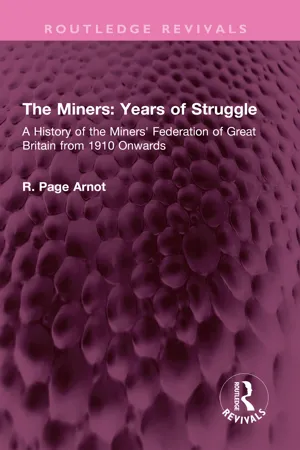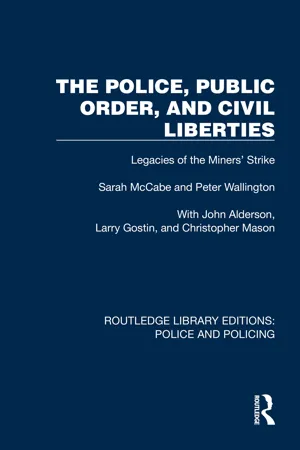History
Miners' Strike
The Miners' Strike refers to a major industrial action that took place in the UK from 1984 to 1985. It was a confrontation between the National Union of Mineworkers and the Conservative government over proposed pit closures and the future of the coal industry. The strike had significant social, economic, and political implications, and its legacy continues to be felt in British society.
Written by Perlego with AI-assistance
Related key terms
7 Key excerpts on "Miners' Strike"
- eBook - ePub
Coal Cultures
Picturing Mining Landscapes and Communities
- Derrick Price(Author)
- 2020(Publication Date)
- Routledge(Publisher)
The Soviet miners’ strike of 1991 helped to change the course of Russian history as the miners supported Boris Yeltsin, and one of their chief demands was the resignation of President Gorbachev. However, this strike marked the apex of working class action in that country and later the miners saw a decline in their living standards and the gradual erosion of their industry. No strike stands as a single event. Each brings with it a particular set of demands and involves political struggle and community action. They can also involve an entire place and community. Take the 1932 strike in Belgium. At the heart of it was the Borinage region where Van Gogh had lived among the miners and painted them in a series of melancholy images. Here, too, the Dutch-born artist Henry Luyten recorded the strike in his huge painting called ‘The Strike’. The struggle also inspired one of the most famous documentary films of the 1930s: Joris Ivens and Henri Storck’s Misère au Borinage, which looked at the woeful condition of the miners, at evictions, the strike and the relationship of this particular struggle to capitalism as a whole. The film ends with a call for the death of capitalism and the rise of the proletariat. The British miners’ strike of 1984/1985 Many strikes might be discussed, then, each of them of great interest and national importance. I have chosen to write about a few, less for the political positions they exemplify, than for the ways in which they were reported and entered public consciousness. They were represented in film, photography, television, song and literature. Indeed, as we shall see, in one instance a strike was brought back from the amnesia of history by a feature film. On the 23rd of April 2004 John Lichfield reported in The Independent newspaper that ‘the French coal miner, a powerful symbol of social revolt and industrial strength for more than a century, passed into extinction’ - eBook - ePub
Literary Politics
The Politics of Literature and the Literature of Politics
- D. Philips, K. Shaw, D. Philips, K. Shaw(Authors)
- 2013(Publication Date)
- Palgrave Macmillan(Publisher)
9 (Re)Writing the 1984–1985 UK Miners’ Strike Katy ShawThe UK miners’ strike of 1984–1985 was a defining moment in the history of the United Kingdom, one that not only illuminates the country’s near-history, but functions as a prism through which to understand the social, political and economic challenges of the twenty-first century. More than twenty-five years on, the strike remains a profound focus of cultural, social and political interest because its legacies are as much about the future of the United Kingdom as its past. From cultures of worklessness and social damage, to the role of regional development agencies and community initiatives, the 1984–1985 UK miners’ strike was instrumental in establishing a range of discourses that came to define the subsequent decades.As the most divisive dispute in our recent history, the 1984–1985 miners’ strike remains a spectre that continues to haunt our contemporary world. Just under the surface of recent events, 1984–1985 is with us still. For a generation of readers born in the ‘Cool Britannia’ of 1990s New Labour, there is a new motivation to look back to the Conservative legacy that bore the political conditions of the present day, to re-examine decades of unrest, division and disquiet both at home and abroad. Since the turn of the millennium, the Thatcher years have become a particularly popular period to reappraise as a result of the global credit crunch. The economic downturn that defined the first decade of the new millennium was relayed by a Western media eager to mobilise the boom and bust, recession and unemployment discourses of the 1970s and 1980s, making the politics of the recent past a more immediate, relatable and felt presence. This chapter will explore the insights offered and challenges faced in illuminating the relationship between literature and politics and the political significance of literary form using some examples of key texts from the heart of the Thatcher years: Tony Harrison’s infamous poem ‘V. - eBook - ePub
- Stephen J. Lee(Author)
- 2005(Publication Date)
- Routledge(Publisher)
In outline, British miners were in dispute with the mineowners who, in 1925, proposed to increase working hours and reduce wages to make the coal industry more competitive. Baldwin's Conservative government tried to prevent a conflict by providing a nine-month subsidy to maintain the existing level of wages; at the same time it appointed the Samuel Commission to propose a longer-term solution. In March 1926 the Commission recommended the ending of the subsidy, along with the introduction of temporary wage cuts until the owners could reorganise the mines more effectively. This was rejected by the owners, who announced a unilateral reduction of wages in April 1926. The miners resisted and appealed to the Trades Union Congress (TUC) for support. The TUC negotiated with the government to try to avert a general strike, which it was prepared to call, if necessary, to back the miners’ cause. When these negotiations broke down between 2 and 3 May, the TUC General Council called out transport and railway workers, printers, gas and electricity workers, and those employed in heavy industry. The remaining workers were to follow in due course. The government, in the meantime, had taken special precautions to combat the effects of the strike. These proved so effective that on 12 May the TUC decided to end the General Strike and accept the Samuel Memorandum. This was, however, rejected by the miners, who were left to fight alone until the end of the year, when the threat of starvation forced them back to work.This chapter deals with three main issues related to the events of 1925– 6. Why did Britain fall over the brink into a general strike in the first place? What was the range of views within the country concerning the strike and the strikers? And what was the significance of the General Strike in the short and longer terms?THE REASONS FOR THE GENERAL STRIKE
Four separate strands have to be disentangled before a full perspective can emerge on the reasons for the General Strike. One is the underlying state of the economy with the contraction of the basic industries and the consequent growth of unemployment and social hardship. The second is the specific impact of such conditions on the coal industry, which suffered more severely than any other. The third is the crisis which developed within the coal industry as the two sides—pit owners and miners— pursued aims which proved irreconcilable. The fourth, and most critical, is the policy pursued by the government to deal with this confrontation.The General Strike occurred during a period of painful economic adjustment. This was due partly to the shrinking of the staple industries such as coal, steel, textiles and heavy engineering which, before the First World War, had accounted for over 50 per cent of Britain's industrial output and 70 per cent of her exports. These continued after 1919 to take up most of Britain's resources and investment, even though they were becoming increasingly inefficient. Little was done to improve or modernise production techniques, in the way that was taking place in the United States and Germany, and the need for urgent readjustment was clouded by the illusion of security created by being on the winning side in the First World War. The problem was compounded by Britain's return to the gold standard in 1925, which inflated the price of exports by about 10 per cent, and by the growing pressure exerted within Britain by the growth of newer and more efficient industries like electricity and gas. As heavy industry became less and less competitive there was a strong tendency to blame lack of productivity on the level of wages, making industrial conflict more and more likely. - eBook - ePub
The Miners: Years of Struggle
A History of the Miners' Federation of Great Britain from 1910 Onwards
- Robert Page Arnot(Author)
- 2023(Publication Date)
- Routledge(Publisher)
Chapter VI The Miners in War-Time 1. Attitude to the War T he war of 1914–18 came as a terrible shock to the British miners as to the other sections of the working class. Thus, though the miners’ unions through their international affiliations, had a better chance than many of anticipating events, their reaction to the outbreak of war was the same as that of the overwhelming majority of the British people. The attitude of the Miners’ Federation of Great Britain had been determined beforehand, both as part of the Labour Party and as part of the International Federation of Miners. The trade union and Labour view on the question of a European war had been very clearly set forth in the 1907 resolution of the International Socialist Congress, to which the Labour Party, the British Socialist Party, the Fabian Society and the Independent Labour Party were affiliated. A second resolution was passed at the Copenhagen International Socialist Congress in 1910 and to this second resolution the Miners’ Federation, having in the meantime joined the Labour Party, was committed as well as to the third resolution passed at the Basel Congress in 1912 to deal with the imminent danger of war - eBook - ePub
Crisis Management in the Power Industry
An Inside Story
- Frank Ledger, Howard Sallis(Authors)
- 2017(Publication Date)
- Routledge(Publisher)
Part IIThe miners’ strike 1984–5
This part tells the compelling story of the miners’ strike of 1984–5, doing so for the first time from the standpoint of the CEGB whose strength and resourcefulness were strained almost to their limits. Keeping the lights on was a statutory duty of the Board, not a weapon in a political battle, a distinction which the board strove to maintain at every stage of this bitter conflict. Yet nobody could doubt that failure to maintain supplies would have changed the course of history. The story concludes with the return of the miners to work with nothing to show for their struggles, with the CEGB returning to normal, and the industry and the nation beginning to count the cost.Note: In parts II and III the word ‘we’ is used frequently in the account of the 1984–5 miners’ strike. It can refer either to the CEGB senior management team of which one of the joint authors was a member or the broader CEGB organisation, depending on the context. In many cases it is not possible to name a single individual who carried out an action since most events involved a wide range of people at all levels and it is convenient to refer to the group as ‘we’.Passage contains an image
Chapter 8
Conflict in context
This chapter is not intended to deal with the immediate causes of the 1984–5 miners’ strike. Rather, it is concerned with the political, economic and industrial relations background which, indirectly rather than directly, helped to determine the attitudes of the NCB, CEGB, NUM and others who were either involved face-to-face or were drawn, in spite of themselves, into the conflict. The account starts towards the end of 1977 where it was left at the end of Chapter 7 - eBook - ePub
Yours for the Union
Class and Community Struggles in South Africa
- Baruch Hirson(Author)
- 2017(Publication Date)
- Zed Books(Publisher)
14. The 1946 Miners’ Strike August 1946The mineworkers’ strike, called for 12 August, led to stoppages on over 30 sites, and involved between 70,000 and 100,000 men over five days. It was an action that aroused intense passion at the time. For the future, it was a clear sign that the black working class was a force which could, and would, play a leading role in the assault on the state. Nevertheless the strike also signalled the eclipse of the CNETU and the industrial organisation of black workers in this period. In the coming decade, their organisations weakened if not smashed, the workers would play only a subordinate role in the struggle against the state, and the political initiative would be grasped by the petty bourgeoisie inside the ANC.The constraints imposed on the mineworkers by the AMWU during its five-year existence, the premature demand for 10s which led to the April/May strikes, and the failure to campaign on the issue of food – all these bungled opportunities now ended in a resolution that the strike take place within one week. The leadership had persuaded the workers on so many occasions to ‘hold their hands’ that they could no longer counsel restraint. They were now confronted with the almost impossible task of organising a strike in an industry that employed over 350,000 workers, in just one week, without a strategy or even so much as the means to get a strike message to workers, most of whom had never heard of the AMWU.1In the week 5–11 August union officials visited the more accessible mines and delivered a simple, unrealistic, but telling message: ‘if you are not paid 10s a day, don’t go to work’.2 In the mines nearest Johannesburg, where the AMWU had its strongest following, active union members (usually tshipa ) and presumably those that attended the conferences in large numbers, spread the message that there would be a strike if 10s was not forthcoming (Beinart, 1984 , p.70). The union printed thousands of leaflets and – with the assistance of the CPSA and volunteers drawn from the ANC, the Indian Congress and student groups – got them into the compounds. The message was simple and direct: all men were entitled to 10s - eBook - ePub
The Police, Public Order, and Civil Liberties
Legacies of the Miners' Strike
- Sarah McCabe, Peter Wallington, John Alderson, Larry Gostin, Christopher Mason(Authors)
- 2023(Publication Date)
- Routledge(Publisher)
Part II The miners’ strike March 1984–March 1985Passage contains an image
Prologue
We have considered the issues of principle relevant to the policing of the miners’ strike, and various background issues relating to the strike itself and to the structure, accountability, and training of the police. These issues must necessarily to some extent be examined first in isolation, as abstract concepts or phenomena are detached from their context. But we must now relate these matters to one of the most important and dramatic episodes of British postwar life.The course of the miners’ strike was exceedingly complex, with a close interweaving of several plots and subplots, personalities, events, and external circumstances; central to the array of developments, however, was the role of the police and the manner of its execution. It will be seen how the newly equipped and trained PSUs, backed by the relatively new NRC, put policing to its severest test, and by the standards and objectives they set were successful: but only at the expense of a grave distortion of police priorities, the final collapse of the local authority limb of the tripartite supervision of policing, the serious depletion of normal policing across the country, major damage to police-community relationships, and massive and often unnecessary assaults on fundamental liberties. These consequences represent the realization of the changes we have described and, as will be seen, have since, so far from leading to a national reappraisal of police, been continued, facilitated, and reinforced.Passage contains an image
5 The progress of the strike
There is little agreement between the participants in the miners’ strike – the government, the Coal Board, the police, the miners and their unions, and, to some extent, the general public – about its purpose, its conduct, and its prospects. Consequently any narrative of its course must seem one-sided or inadequate to one or more of these participants. Besides, much of the business of the strike – arrangements about policing and picketing, for example, or about negotiations for a settlement, or about the financial priorities of the government which determined policing costs and the scale of inducements to miners to return to work – was conducted in secret. Concealment and dissembling were practised by the principal parties to the dispute throughout its course. It is only the publication after the strike of various accounts, memoirs, and sporadic reminiscences that has made it possible to have a more comprehensive view of the actions and motives of the protagonists.1
Index pages curate the most relevant extracts from our library of academic textbooks. They’ve been created using an in-house natural language model (NLM), each adding context and meaning to key research topics.
